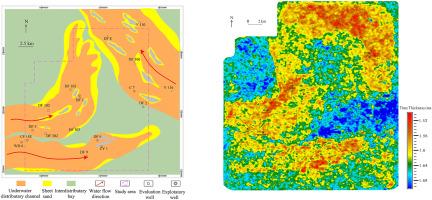Sand body architecture of braided river deltas in the Upper Triassic Xujiahe Formation, Sichuan Basin
IF 3.6
引用次数: 0
Abstract
The recent discovery of natural gas within the fifth member of the Xujiahe Formation (T3x5) in the Dongfeng area within the Sichuan Basin highlights the significant exploration potential of this member. However, the unconvincing previous understanding of the sedimentary microfacies, combined with a total lack of studies on the sand body architecture and reservoir distribution, hampers the further exploration of this member. Using core data, log curves, and seismic data, along with sedimentary microfacies analysis, this study investigated the interfaces between the sand bodies of various scales in the Dongfeng area. Furthermore, this study explored the morphological characteristics, types, and stacking patterns of these sand bodies and determined the distributions of sand bodies and reservoirs in the area. The results indicate that the first sand group of the T3x5 member (T3x51) exhibits delta-front deposits, including subaqueous distributary channels, sheet sands, and interdistributary bays. Seven levels of sand body interfaces are identified in the T3x51 sand group. Among them, the interfaces of the first and second levels were identified only in cores, those of the third and fourth levels were recognizable from cores combined with log curves, while those of the fifth, sixth, and seventh levels were distinguishable using seismic data. Three superimposed subaqueous distributary channel complexes are found in the Dongfeng area. Among them, complex 1 in the northwest exhibits the strongest water body energy, while complex 2 in the south displays the weakest. Complex 2 was formed earlier than complexes 1 and 3. Also, complex 1 is further subdivided into three vertically stacked subaqueous distributary channels. The subdivision of sedimentary microfacies in the T3x5 member reveals nine lithofacies types. Among them, stacked pancake-shaped, carbonaceous debris-bearing, massive, and cross-bedded medium-grained sandstones are considered favorable lithofacies. These four lithofacies types exhibit high porosity, as well as low natural gamma-ray (GR) values, low-to-medium deep investigate double lateral resistivity (RD), and high interval transit time (AC) on the log curves. Additionally, the reservoir distribution in the Dongfeng area was delineated based on the characterization of the favorable lithofacies. This study serves as a guide for future exploration and evaluation of the T3x5 member in the Dongfeng area while also augmenting the methodologies for describing tight sandstone reservoirs.

四川盆地上三叠统须家河组辫状河三角洲砂体构型
近期四川盆地东风地区须家河组五段(T3x5)天然气的发现,凸显了该段具有巨大的勘探潜力。然而,以往对沉积微相的认识缺乏说服力,加之对砂体构型和储层分布的研究不足,阻碍了该段的进一步勘探。利用岩心资料、测井曲线、地震资料,结合沉积微相分析,对东风地区不同规模砂体之间的界面进行了研究。在此基础上,研究了砂体的形态特征、类型和堆积模式,确定了该区砂体和储层的分布。结果表明,T3x5段第一砂组(T3x51)发育三角洲前缘沉积,包括水下分流河道、板状砂和分流间湾。在T3x51砂组中识别出7层砂体界面。其中,一、二级界面仅通过岩心识别,三、四级界面通过岩心结合测井曲线识别,五、六、七层界面通过地震资料识别。在东风地区发现了三个叠加的水下分流河道复合体。其中,西北部的复1水体能量最强,南部的复2水体能量最弱。配合物2的形成早于配合物1和3。复合体1进一步细分为三个垂直堆叠的水下分流河道。T3x5段沉积微相划分显示出9种岩相类型。其中,叠饼状、含碳质碎屑、块状、交错层状中粒砂岩被认为是有利的岩相。这四种岩相类型在测井曲线上表现为高孔隙度、低自然伽马(GR)值、低至中深双侧电阻率(RD)和高间隔透射时间(AC)。根据有利岩相特征,圈定了东风地区储层分布。该研究对今后东风地区T3x5段的勘探评价具有指导意义,同时也丰富了致密砂岩储层的描述方法。
本文章由计算机程序翻译,如有差异,请以英文原文为准。
求助全文
约1分钟内获得全文
求助全文

 求助内容:
求助内容: 应助结果提醒方式:
应助结果提醒方式:


